
The leader in
news and information on
low energy nuclear reactions
March 16, 2007 -- Issue #21
Copyright 2007 New Energy Times (tm)
Published by the New Energy Institute Inc. six times per year
Staff
Editor and Publisher: Steven B. Krivit
Copy Editor: Cindy Goldstein
Web Editor: Sally Robertson
Science Advisers:
Edmund Storms
John Armstrong
Support Team
Randy Souther
H.P.
Nick Palmer
V.F.
John Rudiger
Contributors
Scott Chubb
Dr. Robert Deck
Akito Takahashi
Anonymous
New Energy Times (tm)
369-B Third Street, #556
San Rafael, CA 94901
(310) 470-8189
|
New Energy Times (tm) is a project of New Energy Institute, an independent 501(c)(3) nonprofit corporation that provides information and educational services to help bring about the clean-energy revolution.
|
__________________________________________________________________________________
New Energy Institute gratefully acknowledges the generosity and support of our major sponsors:
Anonymous
Harold A. and Marian L. Poling
Jim Newburn
__________________________________________________________________________________
EDITORIALS AND OPINION
1. From the Editor
2. To the Editor
NEWS & ANNOUNCEMENTS
3. Ice Thaws for Naval Research Lab: LENR Manuscript Accepted; Reproducible Cathode Material Reported
4. Purdue Integrity Panel Completes Research Inquiry
5. Death of Cold Fusion Opponent Albert Cotton Under Investigation
6. 8th International Workshop on Anomalies in Hydrogen- and Deuterium-Loaded Metals
7. The 233rd American Chemical Society National Meeting
8. Melvin Miles Gives Low Energy Nuclear Reaction Lecture At University Of La Verne
9. 1989 University of Utah Cold Fusion Press Conference
ANALYSIS AND PERSPECTIVES
10. Extraordinary Courage: Report on Some LENR Presentations at the 2007 American Physical Society Meeting
11. Science Cold Fusion Attack Story Fabricated
12. Widom-Larsen Theory Debate
13. PUBLICATIONS
14. SCIENCE AND ENERGY NEWS
__________________________________________________________________________________
“Theories have four stages of acceptance: i) this is worthless nonsense;
ii) this is an interesting, but perverse, point of view; iii) this is true, but quite unimportant; iv) I always said so.”
— J.B.S. Haldane, 1963 |
__________________________________________________________________________________
EDITORIALS AND OPINION
1. Editorial:
All That Glitters: Is Solar Done With D2Fusion?
By Steven Krivit

Photo: Daniel Bosler |
[This is a follow-up story to the New Energy Times investigation into D2Fusion Inc. and Russ George, published May 10, 2006.]
As the 12th International Conference on Condensed Matter Nuclear Science in Yokohama, Japan, came to a close Dec. 1, 2005, CMNS researchers were raving about Russ George's latest "cold fusion" start-up, D2Fusion Inc.
One veteran of the field reportedly cashed in some of his investment retirement account and purchased 10,000 shares of D2Fusion's parent company, Solar Energy Ltd.
|
Sadly, the dreams of quick cold fusion riches and much-needed research and development dollars may have evaporated for people who jumped on the D2Fusion and Solar bandwagon in good faith.
| According to a Feb. 20 press release from D2Fusion Inc., "D2Fusion" is about to change hands. Russ George's new suitor-in-waiting, Shadow Marketing Inc. (OTCBB: SDWM), was "pleased to announce" an offer to purchase up to a 100 percent interest in D2Fusion Inc. from its parent company, Solar Energy Ltd., for what appears to be a price of $0. This is in contrast to the "$2 million of investment" that Russ George had received two years ago from Solar Energy Ltd. As it turns out, that $2 million never existed in hard currency and was only a debenture, an unsecured debt backed only by the integrity of the borrower. |
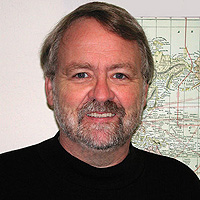 Russ George
Russ George |
According to SEC documents, Shadow Marketing Inc. is "involved in the publication of Up & Over magazine, a periodical focusing on issues related to the purchase, training and care of sports horses. It includes training tips, riding techniques, health concerns and horses for sale." SEC documents state that one issue of Up & Over magazine was published since the company's inception in 2003; "a lack of working capital" has prevented subsequent publication.
Shadow Marketing would be required to raise $2,000,000 in working capital to fund D2Fusion’s business plan. In other words, with a bit of spin, D2Fusion appeared to be backed by $2 million, but it more likely was attempting to fund its research on the backs of other people's money in the penny stock trade.
In related news, Russ George's other "company," Diatom Corp.,
announced March 7 that it plans to change its name to Planktos Corp. and has entered into an agreement with Solar Energy Ltd. to acquire Planktos Inc. No purchase price was stated.
If Solar Energy Ltd. (http://www.solarenergylimited.com) goes through with the transaction, what will Solar consist of, then, without D2Fusion and Planktos, if it is not merely a shell company with which to play financial games at other people's expense?
New Energy Times commends Russ George for his vision and mission: "to develop and deliver practical solid-state fusion energy applications that will both help rescue the planet and provide premier investment opportunities."
However, we must ask, Was his public promotion of D2Fusion anything more than a clever facade? Was his 2005 promotion of marketing multikilowatt reactors by the end of 2006 responsible?
__________________________________________________________________________________
2. To the Editor
To the editor:
For half a century, science has promised safe, economical, benign electricity generated by nuclear fusion. Billions of dollars to support high-energy physics research have failed to develop fusion power. Still, huge experimental reactors (ITER, Z-pinch, NIF, NSTX) investigate elusive, expensive, and exotic fusion fuels. More billions are needed to develop the same-old, same-old magnetic and inertial plasma containment technologies. Electricity from fusion remains 50 years in the future. My profession, engineering, applies technology to societal needs. There is no greater or more urgent societal need than cheap, safe, benign generation of electricity. Cold fusion technology is available. My lab and others are developing storable fusion fuel and fusion furnaces. Within a decade, this technology will replace coal fired boilers in electricity generation.
This memo calls a spade a spade. High-energy physics' highfalutin’ magniloquence and faith in exotic mysteries, ghostly fields, looking-glass worlds, hidden particle zoos, and intellectual sophistry is no substitute for progress. The last 50 years were a golden age of progress for solid state physics, computer science, communications, aviation, space, chemistry, photography, medicine, and all other sciences. It is sad that high-energy physics, the most prestigious of all sciences, profoundly failed to progress in this era.
Evan Ragland
Evan Ragland graduated from the U. S. Navy Electronics School in World War II, received a bachelor’s degree in electrical engineering from Mississippi State University in 1949, attended the University of Michigan summer session on computers in 1955, and graduated from Lake Forest University’s Graduate School of School of Management in 1962.
He has practiced engineering since 1949 and has been in the computer industry since the early days of Illiac, Maniac, Whirlwind, and Univac. From 1949 through 1968, he was on the research staffs of Victor Comptometer, Motorola, and Singer.
In 1968, he founded Regitel Corp. to develop computer point-of-sale and credit transaction systems for most of the major department stores in America. His principal contributions to the industry have been development of computer-related technology and systems. Three of the most far-reaching are digital-to-voice conversion, which is the genesis for telephone answering, the Regitel point-of-sale system, which he pioneered, and the daisy-wheel printer, which he developed.
Ragland holds eight U.S. and a number of foreign patents and is the author of numerous technical papers. From 1961 to 1964, he served on the advisory council to the Motorola board of directors. His original daisy-wheel printer has been in the computer and math collection of the Smithsonian National Museum of American History since 1991. The Smithsonian added his Regitel Model I point-of-sale terminal to the collection in 2002. On Nov. 13 2002, Mississippi State University’s Department of Physics and Astronomy dedicated the Evan Ragland Advanced Physics Laboratory in his honor.
EFTS Corp., which he founded in 1976, pioneered the development of online electronic funds transfer systems for American Express, major banks, and most major department stores. He is often called “the father of point-of-sale.” Since retiring in 1985, he has focused on nuclear theory.
Ragland sold American Regitel Corp. to General Instrument Corp. in 1974 and served as vice president of General Instrument until he founded American EFTS Corp. in 1976. He sold American EFTS to Exxon Enterprises in 1978. In 1978, he founded Evan Ragland Research Associates in the Stanford University Professional Center, Palo Alto, Calif.
(Letters may be sent to "letters" at the New Energy Times domain name. Please include your name, city, and state or province.)
__________________________________________________________________________________
NEWS & ANNOUNCEMENTS
3. Ice Thaws for Naval Research Lab: LENR Manuscript Accepted; Reproducible Cathode Material Reported
The ice is beginning to thaw for researchers involved in the field formerly known as cold fusion. New Energy Times learned on March 16 of the acceptance by the Elsevier publication journal Surface & Coatings Technology of a low energy nuclear reaction paper by Graham K. Hubler.
Hubler is the head of the materials and sensors branch at the Naval Research Laboratory. He was involved in LENR research from 1989 through the early 1990s, until funding dried up, and he was able to resume research around 1998. This is the first LENR paper he has published in a journal.
Of particular note in Hubler's review paper is the claim that the group at the Italian National Agency for New Technologies, Energy and the Environment in Frascati, led by Vittorio Violante, has developed a method to prepare palladium in such a manner that it can hold the required ratio of deuterium needed to produce the excess heat effect with 100 percent repeatability. Results of the success rate of the excess heat effect are still under investigation.
Hubler writes that, from 1989 to 1990, "one reason that most researchers were unsuccessful in achieving heat production may have been at least in part due to the lack of understanding of how to achieve a deuterium/palladium ratio greater than 0.95."
"Unable to achieve high loading," Hubler writes, "and, therefore, excess heat, most researchers declared that heat production in Fleischmann and Pons cells is not a real effect and ceased working on the experiments."
Violante has been studying the metallurgical properties of palladium intensely over the last 18 years, and the fruits of his labor may be the most important experimental development so far in the generation of excess heat.
A source who wished to remain anonymous reported that four laboratories, three in the U.S. and one in Israel, have reproduced the loading effect.
Abstract (from an unproofed pre-print)
More than 10 groups worldwide have reported the measurement of excess heat in one-third of their experiments in open and/or closed electrochemical cells with a Pd solid metal cathode and deuterium containing electrolyte, or D2 gas loading of Pd powders.
Most of these groups occasionally have experienced significant events lasting for hours or days, with 50 percent to 200 percent excess heat measured as the ratio between electrical input energy and heat output energy. Moreover, these experimenters have improved their methods over time, and the reported excess heat effect has not diminished in frequency or magnitude.
This paper cites selected data generated over the past 15 years to summarize briefly what has been reported about the production of excess heat in Pd cathodes charged with deuterium. A set of new materials experiments is suggested that, if performed, may help to reveal the underlying mechanism(s) responsible for the reported excess heat.
Summary Paper—Experimental View—Excess Heat
Hubler, G., "Anomalous Effects in Hydrogen-Charged Palladium—A Review," Journal of Surface & Coatings Technology (10.1016/j.surfcoat.2006.03.062)
__________________________________________________________________________________
4. Purdue Integrity Panel Completes Research Inquiry
Purdue News Service
Wednesday, February 7, 2007
WEST LAFAYETTE, Ind.—A Purdue University committee appointed to conduct an initial inquiry into internal allegations of research misconduct at Purdue by a professor of nuclear engineering has concluded its work. The committee determined that the evidence does not support the allegations of research misconduct and that no further investigation of the allegations is warranted.
The committee was appointed in the College of Engineering under the university's policy on integrity in research to consider allegations against Professor Rusi P. Taleyarkhan regarding a reported confirmation at Purdue of sonofusion, the use of sonic waves in a table-top apparatus to produce nuclear fusion.
Purdue's policy on integrity in research requires that all allegations of research misconduct be reviewed under procedures that ensure strict confidentiality. The policy states:
"The mere suspicion or allegation of wrongdoing, even if totally unjustified, is potentially damaging to a person's career. Consequently, no information about charges of a lack of integrity in research may be disclosed except to the appropriate university and federal authorities."
However, in the interest of ending speculation regarding Purdue's inquiry, Dr. Taleyarkhan has agreed to allow the university to confirm the existence of the internal review and disclose its final result, according to Joseph L. Bennett, vice president for university relations at Purdue. "Professor Taleyarkhan cooperated fully throughout the inquiry," Bennett said.
"Research at a university must be conducted with absolute integrity. When Purdue received internal allegations of research misconduct, Purdue pursued those allegations thoroughly to conclusion in accordance with the confidential procedures required by its published policy. Professor Taleyarkhan is engaged in very promising, significant research, and we hope he will now be able to give his full attention to this important work. Purdue believes that vigorous, open debate of the scientific merits of this new technology is the most appropriate focus going forward."
Taleyarkhan led a research team at the Oak Ridge National Laboratory that first reported the "bubble fusion" phenomenon in a 2002 paper published in the journal Science. Those researchers later conducted additional research at Oak Ridge, Rensselaer Polytechnic Institute and the Russian Academy of Sciences before Taleyarkhan came to Purdue in 2003 to continue his research. In March 2004 and January 2006 his group published their second and third papers on this subject.
Scientists have long known that high-frequency sound waves cause the formation of cavities and bubbles in liquid, a process known as "acoustic cavitation," and that those cavities then implode, producing high temperatures and light in a phenomenon called "sonoluminescence." Researchers have estimated that temperatures inside the imploding bubbles reach 10 million degrees Celsius and pressures comparable to 1,000 million earth atmospheres at sea level.
Nuclear fusion reactors have historically required large, expensive machines, but acoustic cavitation devices might be built for a fraction of the cost.
__________________________________________________________________________________
5. Death of Cold Fusion Opponent Albert Cotton Under Investigation
By Steven Krivit
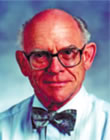 Officials are investigating the death of Texas A&M chemistry professor Frank Albert Cotton on February 21, 2007.
Officials are investigating the death of Texas A&M chemistry professor Frank Albert Cotton on February 21, 2007.
Officer Fred Kindell of the Brazos County Sheriff's Department told New Energy Times on March 16 that the department has an open investigation into Cotton's death. Kindell refused to answer further questions.
Cotton, a distinguished professor of chemistry at Texas A&M University, is known to the New Energy Times community for a vicious but failed campaign in 1994 to revoke cold fusion pioneer John O'Mara Bockris' distinguished professor title. Cotton objected to cold fusion research by Bockris, also a Texas A&M professor.
According to a 1994 letter from some of Cotton's colleagues in the chemistry department, Cotton was coercive, intimidating and a threat to academic freedom.
Lane Stephenson of Texas A&M University Relations told New Energy Times on March 16 that he believed Cotton's death was the result of old age. Stephenson said he was unaware that the county was investigating the death.
The Bryan-College Station Eagle reported the death of Cotton, whom it called "a distinguished professor of chemistry at Texas A&M University and one of the most honored faculty members in Aggieland history."
Chemical & Engineering News reported on February 26 that Cotton, a "world-renowned inorganic chemist, died from complications stemming from a head injury he suffered from a fall in October."
A former Texas A&M staff member reported to New Energy Times a rumor circulating at the university about Cotton's death.
"In the chemistry department at Texas A&M, it seems to be hush hush about Cotton's death," the ex-employee said. "The staff is not allowed to discuss it.
"Cotton was at home and had pneumonia. He lived out in the country about 40 miles from town. He told his wife he was going for a walk and would be back at such-and-such time. The time came and went, so they went to look for him.
"It is said that he died from pneumonia, but when they found him, he was on his back, and his face was all smashed up. They said it was because of his falling as he was dying, but [because of] the degree to which his face was scratched and marked up, it seems to be a beating."
The former staff member said, "Texas A&M has had no memorial service for him."
__________________________________________________________________________________
6. 8th International Workshop on Anomalies in Hydrogen- and Deuterium-Loaded Metals
The honorable secretary of the International Society of Condensed Matter Nuclear Science, William Collis, has announced the next Workshop on Anomalies in Hydrogen- and Deuterium-loaded Metals.
The workshop will take place Oct. 13-18, 2007 at the Sheraton Catania hotel and conference center in Cannizzaro, Sicily, Italy.
Joining Collis on the organizing committee are Antonio Spallone, Sebastiano Truglio, Fulvio Frisone and Xing Zhong Li.
The early registration deadline is June 30. For more information, send requests to catania@iscmns.org or visit the Web site: http://www.iscmns.org/catania07.
__________________________________________________________________________________
7. The 233rd American Chemical Society National Meeting
Chicago, Illinois, March 25-29, 2007
ACS—Division of Environmental Chemistry
New Energy Technology—Low Energy Nuclear Transmutation
Organizer: Jan Marwan
Thursday, March 29, 8:30-11:00 a.m., 1:30-3:00 p.m.
McCormick Place South—Room S106B, Level 1
Session 1: http://oasys2.confex.com/acs/233nm/techprogram/S23460.HTM
Session 2: http://oasys2.confex.com/acs/233nm/techprogram/S22598.HTM
| 8:30 a.m. | From cold fusion to low energy nuclear reactions: 2007 Update, Steven B. Krivit | | 8:55 a.m. | Experimental observation of reactor 137Cs isotope deactivation and 55Mn isotope transmutation in biological cells, Vladimir Vysotskii, Alexander Tashirev, Alla Kornilova | |
9:20 a.m. | Precision and accuracy of cold fusion calorimetry, Melvin H. Miles, Martin Fleischmann | |
9:45 a.m. | Resonance transfer of neutron from deuteron: Mechanism of low energy nucleus reactions in metals, Dmitriy D. Afonichev II | |
10:10 a.m. | On the energetics of deuterium palladium cluster reactions in LENR electrolytic experiments, George H. Miley, Heinz Hora | |
10:35 a.m. | Quantization of atomic and nuclear rest masses and stimulation mechanisms of low energy nuclear reactions using super low energy external fields, Fangi Gareev |
| 1:30 p.m. | Pd/D CO-deposition: Excess power generation and its origin, P. A. Mosier-Boss, Stanislaw Szpak, Frank E. Gordon | |
1:55 p.m. | Study of the nanostructured palladium hydride system, Jan Marwan | |
2:20 p.m. | Miniature microbial fuel cells incorporating nanoporous sterilization membranes,
Justin C. Biffinger, Ricky Ray, Brenda Little, Bradley R. Ringeisen | |
2:40 p.m. | Pressure pulsing: A dynamic method for enhancing environmental remediation,
T. J. T. Spanos |
__________________________________________________________________________________
8. Melvin Miles Gives Low Energy Nuclear Reaction Lecture At University Of La Verne
The concept and the controversy surrounding low energy nuclear reactions, historically known as cold fusion, are once again a topic of interest involving both academic and corporate researchers. Melvin Miles, adjunct professor at the University of La Verne in La Verne, California, contributed to the discussion with his lecture "Navy Research and the Future of Cold Fusion" on February 13 in the university's Presidents Dining Room. The lecture was co-sponsored by the faculty research committee and the University of La Verne Academy.
The ULV lecture was the first in a series of talks Miles will give during the next two months. He presented his paper "Precision and Accuracy of Cold Fusion Calorimetry" at the American Physical Society's March 5-9 meeting in Denver and he has also been invited to present at the American Chemical Society National Meeting March 25-29 in Chicago.
Miles earned a Ph.D. in Physical Chemistry from the University of Utah in 1966. He has been teaching chemistry at ULV since 2002, initially as a visiting professor and most recently as an adjunct professor while also doing research on thermal batteries at the Naval Weapons Center in China Lake, California. He has also been a visiting professor at Bates College in Maine and at Middle Tennessee State University.
Prior to teaching, Miles served 24 years as a researcher for the U.S. Navy. In 1997-98 he was the NEDO Guest Researcher at the R&D Center for New Hydrogen Energy at the Institute of Applied Energy in Sapporo, Japan. He has authored 185 scientific publications and made 125 presentations at scientific meetings.
__________________________________________________________________________________
9. 1989 University of Utah Cold Fusion Press Conference
Original videotape footage, audio recording and a transcript are now available from this historic press conference. Thanks to volunteeers Nick Palmer and John Rudiger for their help with this project.
March 23, 1989 University of Utah Press Conference Videotape
March 23, 1989 University of Utah Press Conference Audiotape
March 23, 1989 University of Utah Press Conference Transcript
__________________________________________________________________________________
ANALYSIS AND PERSPECTIVES
10. Extraordinary Courage: Report on Some LENR Presentations at the 2007 American Physical Society Meeting
Printer-Friendly PDF Version
By Steven Krivit
[This is the third in a series of articles relating to the SPAWAR San Diego co-deposition experiment and the New Energy Institute Galileo Project, reported previously in the September 10, 2006 and November 10, 2006 issues of New Energy Times.]
At 8 a.m. sharp, the presentations at the American Physical Society March meeting, billed as the largest physics conference in the world, kicked off at the Colorado Convention Center in downtown Denver.
Members of the condensed matter nuclear science community, science press and military personnel listened to 18 presentations on the field formerly known as cold fusion. The tenor of the meeting was generally low-key, with the exception of a barrage of technical questions from one member of the audience from Lockheed Martin.
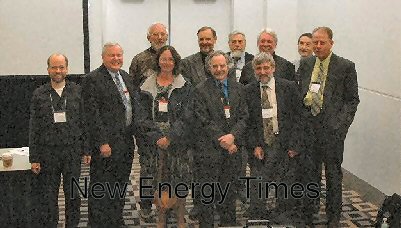
Photo: S. Krivit
LENR Researchers at APS 2007. From left to right: Winthrop Williams, Frank Gordon, Edmund Storms, Pamela Mosier-Boss, Michael Melich, Larry Forsley, John Dash, Scott Chubb, Michael McKubre, Ludwik Kowalski, Melvin Miles. (Not pictured: Roger Stringham, George Miley, Heinrich Hora, Peter Hagelstein.)
|
|
Four of these presentations, including a last-minute surprise presentation by Ludwik Kowalski, a retired physics professor from Montclair State University, reported new research based on the SPAWAR co-deposition experiment. This experiment, which uses the electrochemical co-deposition method developed by SPAWAR researchers Stan Szpak and Pamela Mosier-Boss, claimed to be repeatable on demand by its originators, also appears to be reproducible by others on demand. Two independent replicators, participants in the New Energy Institute Galileo Project, both showed similar evidence of particle emissions from their replications of the SPAWAR experiment. This appears to be the first highly reproducible nuclear evidence in the 18-year history of this field.
|
The results that were reported are intriguing and encouraging, though not all researchers shared similar conclusions about their work. The major struggle facing the researchers is detection limits, not having the ideal tools for post-experiment analysis. High-resolution optical microscopes with rear illumination has not been easily available to all researchers, nor has automated scanning equipment and software to collect and analyze data from the thousands of pits often seen in these CR-39 detectors. As well, most of the researchers have not taken the time to perform sequential etching, which would provide added confidence that the pits seen show the expected geometry, the conical shape, of a particle track.
|
Slide Presentations and Video Recordings
Pamela Mosier-Boss et al., "Production of High Energy Particles Using the Pd/D Co-Deposition Process" |
Slide presentation |
Video |
Larry Forsley et al., "Time Resolved, High Resolution, Gamma-Ray and Integrated Charge and Knock-on Particle Measurements of Pd:D Co-deposition Cells" |
Slide presentation |
Video |
Steven B. Krivit, New Energy Times, "Low Energy Nuclear Reactions: 2007 Update" |
Slide presentation |
Video |
Winthrop Williams et al., U.C. Berkeley, "Search for Charged Particle Tracks Using CR-39 Detectors to Replicate the SPAWAR Pd/D External Field Co-Deposition Protocol" |
Slide presentation |
Video |
Ludwik Kowalski et al., Montclair State Univ., "Our Galileo Project March 2007 Report" |
Slide presentation |
Video |
|
Winthrop Williams, a physicist on staff at the University of California, Berkeley, and Kowalski each followed the Galileo Project experimental protocol rigorously and were rewarded with clear data. Kowalski's very first attempt at the experiment was successful. Williams' first attempt may have been successful; however, the batch of CR-39 he initially used did not hold up well to the electrochemical environment and resulted in a fogging appearance that covered most of the detector. Williams' second experiment, using a different batch of CR-39 detectors, showed clearer results.
The core of the SPAWAR method is the use of the electrochemical co-deposition method. The essential benefit of this method over other LENR methods is that the required loading ratio (atomic ratio) between palladium and deuterium is achieved easily, instantly and reliably. LENR researchers agree that a minimum loading ratio must be achieved in order to expect to see an apparently nuclear reaction. A ratio below 80 percent rarely yields positive results, a ratio of 85 percent shows some results, and a ratio of 90 percent to 100 percent, if attained, almost always produces a reaction, so long as the other parametric requirements are in place. In most experiments, a minimum current density is required, as well as a dynamic trigger, though these second and third parametric requirements are not as critical as the loading ratio, particularly when experiments use the co-deposition method. In the famous claims of the "failures to replicate" the results of Fleischmann and Pons in 1989, the chief reason for their failure to obtain a positive result was an insufficient loading ratio. For example, Nathan Lewis, at Caltech, reached a maximum loading of only 80 percent in his team's cold fusion experiment.
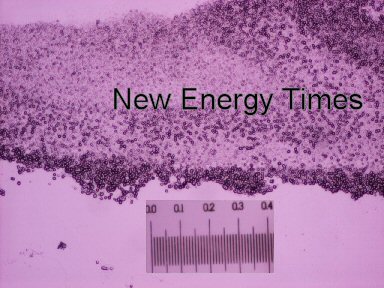
Photo: L. Kowalski
Tracks from Pd/D co-deposition cell from Montclair State University. Smallest marks in scale are 10 microns apart. Click for larger image.
|
|
Kowalski's interpretation and presentation at APS was somewhat ambiguous; however, his results looked identical to those of SPAWAR. Shown below is a 40x magnification photograph of the CR-39 detector from the vicinity of the silver cathode wire in his experiment. The overall pattern of pits is spatially related to the cathode wire, and within this view, distribution patterns parallel to the cathode wire are visible. Also visible are precisely defined pits with clean, distinct circumferences and uniformity in size and contrast.
The detector showed tracks only where the cathode wires were closest to the chip, right near the edge where they were attached to the detector.
Kowalski's abstract says, "Our attempt to replicate a SPAWAR [LENR co-deposition] experiment was highly successful. Like SPAWAR researchers, we observed copious pits at the detector near the silver cathode in an electrolytic cell with magnets and no such pits in an identical cell without magnets."
Kowalski's interpretation of the pits left some ambiguity; he and Steven Krivit discussed these ambiguities in detail after the conference.
|
"It's Not Real Science Without a Published Paper"
At the APS meeting Mosier-Boss presented improved photomicrographs and a review of a broad array of tests performed to isolate various possible contaminations that might be responsible for false positives. She also displayed images depicting different types of chemical damage that could occur by the use of CR-39 detectors in electrolytic solutions.
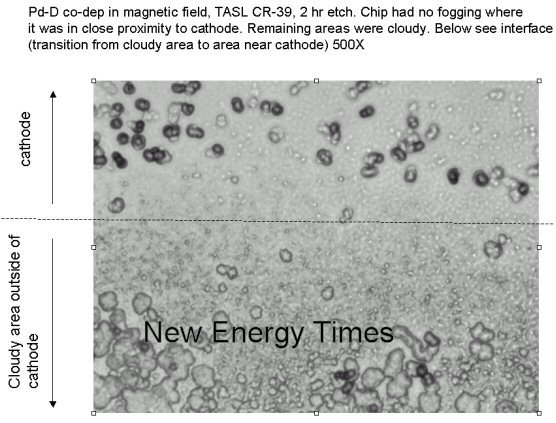
Chemical damage shown adjacent to apparent particle tracks.
Her paper, "Further Evidence of Nuclear Reactions in the Pd/D Lattice: Emission of Charged Particles," was written with colleagues Stan Szpak and Frank Gordon of SPAWAR and published a few weeks ago in Naturwissenschaften. The process took six months with Naturwissenschaften. They had submitted it to three other journals before that, though none of the other journals was willing to send it out for review.
The application to the first journal, personally transmitted to an editor through an associate of theirs, was rejected with the comment, "[The authors] would be best advised to seek publication elsewhere. I can only speak for [our journal], and we wouldn't want it, but I doubt that they'd get much joy at [our other journals], sorry."
The second journal editor to reject it stated, "We are not persuaded that the firm conclusions that can be drawn from this current work will have a sufficiently immediate impact on our broader readership to justify publication."
The third journal editor to refuse to send the paper out for review wrote, "While your observations of charged particles emitted during electrolysis may well be of some interest to others in the field, I am afraid that, based on the brief information provided, we are not persuaded that these specific results will be of sufficiently immediate and general conceptual and fundamental interest to a wide materials research readership or represent a sufficient technological advance. ... I hope you will rapidly receive a more favourable response elsewhere."
New Energy Times asked Gordon for a clarification on their use of the term "reproducible" in the SPAWAR paper. He explained that their group is able to repeat the experiment on demand and that, in the 2006 spring semester, a group of students at University of California San Diego replicated their results. New Energy Times noticed that SPAWAR did not cite the published Widom-Larsen paper which also discusses a low energy neutron theory.
Limitations of Detection Limits: A Chemist's Perspective on CR-39 Analysis
On its path of destruction through the CR-39 plastic, an electromagnetic interaction occurs between charged particles and the plastic, breaking the chemical bonds, which causes the resulting pit. Neutrons do not cause pits, because they have no electrical charge, but they can knock onto other nuclei, like billiard balls, which then, in turn, result in pits.
What is not visible from many photographs from these experiments is the telltale sign of the pinpoint of the conical etch-pit, indicative of the path of the particle responsible for the pit. A charged particle passing through the detector would be on the order of one-billionth the size of the overall pit. A minimum of 500 or 1000x magnification is required even to get close to seeing a conical shape.
Even then, it can be challenging. Also, most of the results from these experiments typically suggest particle impacts that are normal—that is, perpendicular to the surface of the detector. Consequently, only a few tracks show signs of gross ellipticity. However, when researchers have performed automated scans of thousands of pits per detector, they have reported statistically significant ellipticity.
The appearance of a conical shape, with a pinpoint tip in the center of the pits on these detectors is an important aspect of detection and interpretation. Such pinpoints are difficult to explain by any means other than a charged particle track. The diagram below represents a variety of the different type of tracks that CR-39 detectors can show. The blue circle shows a pair of tracks, one on the front (facing toward the emitting device) and another on the backside (facing away from the emitting device) that are spatially aligned. Where spatially-correlated pits appear on the front and backside of CR-39 detectors, the question of the existence of a nuclear reaction becomes nearly indisputable.
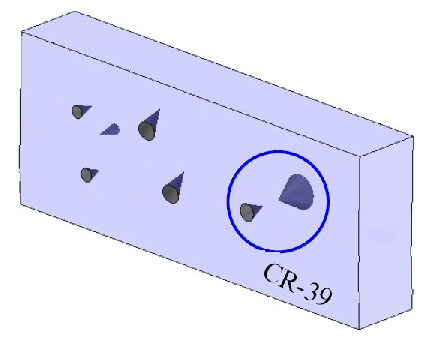
Diagram modified from original diagram by Michael J. Canavan of MIT
The best optical technique to view this conical shape is to be sitting at the microscope and operate the focus adjustment to observe the changing depth of field through the focus adjustment. Perhaps someone will connect a video camera to one of these microscopes someday so the rest of us can "look through the microscope," but for now, we are limited to still, digital images.
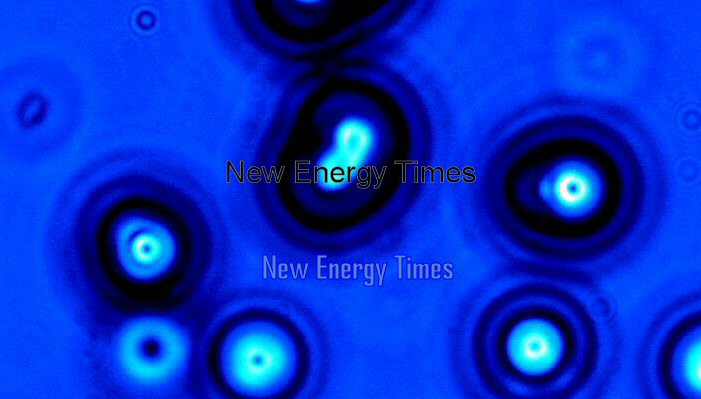
Photo: P. Mosier-Boss
High-contrast, color-enhanced image showing tiny point in center of pit.
Recent developments from Mosier-Boss' research incorporates improved photomicrography and color and contrast enhancements to help present a slightly three-dimensional view of the etched detectors in a two-dimensional medium such as a photograph. Mosier-Boss has started using a method which combines an overlay of two focus depths of the same view.
Mosier-Boss has used the overlay method on her own, as well as on other detectors from other participants in the Galileo Project. The first image shows a monochrome, single-depth image of pits from an experiment performed by Kowalski.
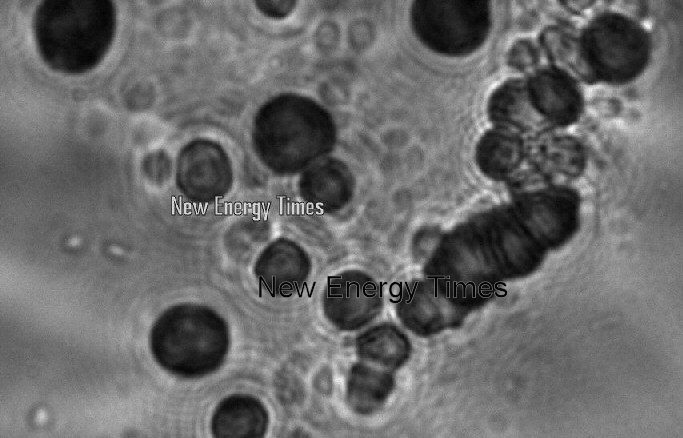
Photo: P. Mosier-Boss
Monochrome, single-depth image of Kowalski experiment.
The next image is the same view but an overlay of two images, one focused toward the surface of the pit, the other focused toward the point of the pit, and the two distinguished with two colors. A concentric radial pattern terminating in a pinpoint supports the claim of the presence of the expected conical geometry of a particle track.
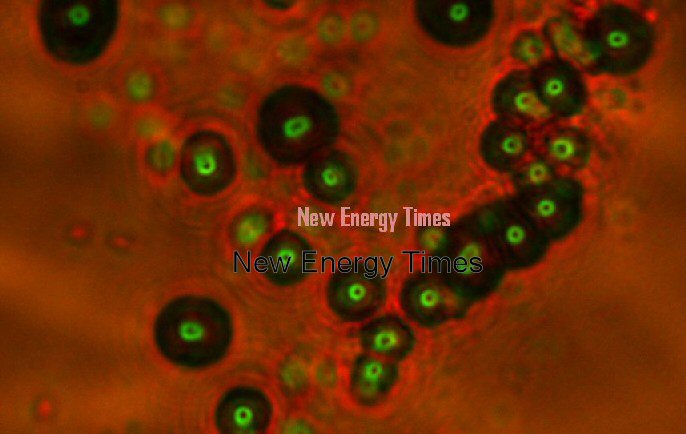
Photo: P. Mosier-Boss
Color overlay of Kowalski experiment.
The next two images show another, wider field of view of the Kowalski CR-39 detector. Again, the difference between the two types of images is readily apparent.
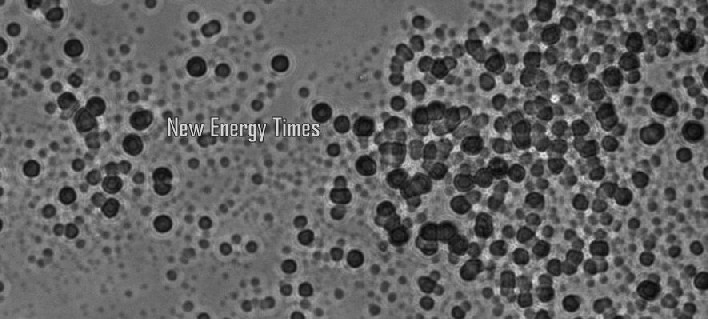
Photo: P. Mosier-Boss
Monochrome, single-depth image of Kowalski experiment.
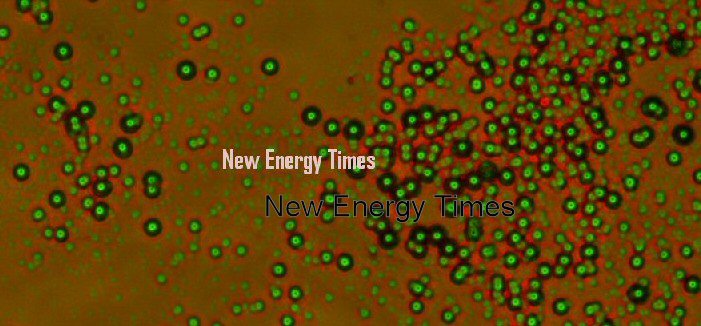
Photo: P. Mosier-Boss
Color overlay of Kowalski experiment.
Also at the APS meeting, Winthrop Williams, a physicist with U.C. Berkeley reported seeing similar pits, though again, the resolution of his digital image does not support a clear interpretation of the pits. Two interesting things are apparent. First, the distributions of the pits are in two groups; one about 2.5 times larger than the other. Second, Williams' cell #2 did not have magnets yet produced pits. As Williams reported, he has more work ahead of him to make sense of these observations.
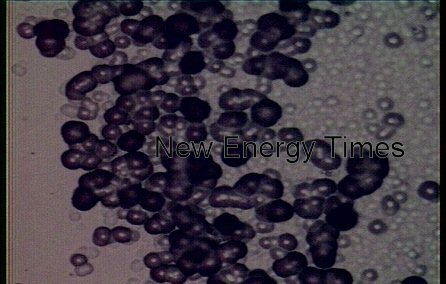
Photo: W. Williams
Williams Experiment #2, Cell #1, Design #1, with magnets.
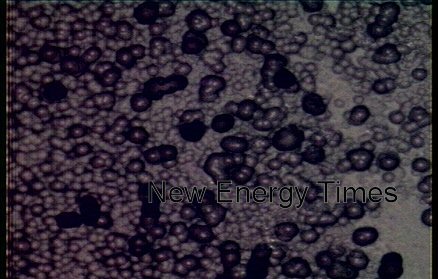
Photo: W. Williams
Williams Experiment #2, Cell #2, Design #1 with magnets.
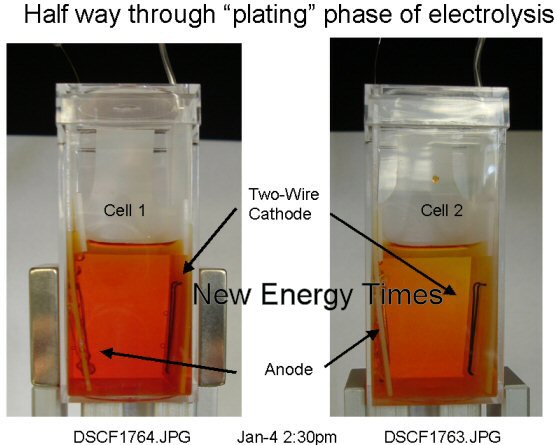
Diagram of William's cell design #1 (Replication of SPAWAR design).
A Physicist's Analysis
Forsley, who is working with the SPAWAR group, presented a rapid-fire download of an array of data that suggested their experiments had shown evidence of gamma ray emission and knock-on tracks from neutral particles. His fourth slide showed results of apparent tracks from "dry" CR-39 experiments, where the CR-39 is physically and chemically isolated from the electrolyte by a thin barrier. The track density is far lower than in "wet" experiments, where the detectors are immersed in the electrolyte. However, Mosier-Boss later confirmed that the track count was more than seven times the background.
Forsley's fifth slide showed a graphical data analysis of the detected tracks obtained by the use of an automated computer scanning system. The extraordinary track density is not news to New Energy Times readers. However, the visual display of track distributions on a single detector with three cathode wires strung across it provides a remarkably clear illustration.
But wait, there's more—tracks on the backside of the CR-39. How did they get there? Is there any other imaginable mechanism that can pit holes through this piece of hard plastic, sitting in a low-power electrolytic solution? And are the holes on the backside coming through the material, or are they just random pits created by some prosaic mechanism? There is a distinct spatial relationship of the pits on the backside to the pits on the front side.
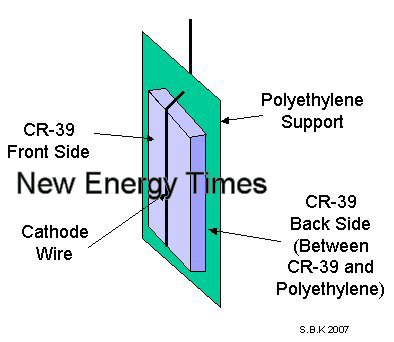
Diagram Showing Front and Back Side Relationship to CR-39 Detector
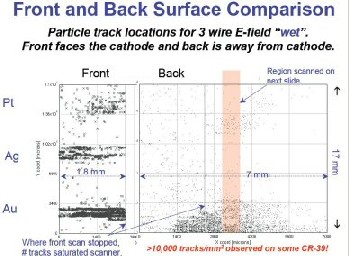
Computer analysis of SPAWAR CR-39 detector showing front
and rear track correlation Click for larger image.
|

Detail of computer analysis of SPAWAR CR-39 detector showing front and rear track correlation. Click for larger image.
|
Mosier-Boss was the first to find the tracks on the back side—by accident.
"One day while taking images of an experiment," Mosier-Boss wrote, "we discovered that the focus was actually on the back of the chip and that there were pits on the backside of the CR-39, as well as the front side. As the CR-39 chip is ~1 mm thick, the implications are that either very energetic charged particles went through or the pits are due to knock-ons created by neutral particles traversing the chip."
Forsley's seventh slide shows something interesting, as well. In the first image, he displays a spectrum of alpha track diameters from a calibration experiment using uranium-238. It shows a narrow peak around two microns, a major range between 6 and 14 microns. A spectrum of pit sizes from the SPAWAR experiment shows a nearly identically shaped curve and range; however, the Pd/D experiment has far fewer pits.
|
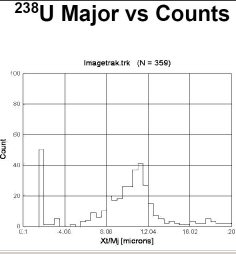
Distribution of Major Axis of Pit Sizes
From Alpha Particles From U238 Source
|
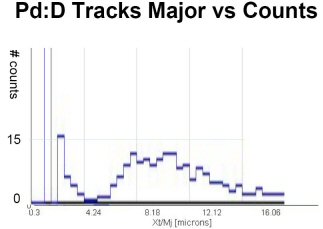
Distribution of Major Axis of Pit Sizes
From SPAWAR Pd/D Experiment
|
A similarly shaped curve and distribution range was displayed by Williams in his APS presentation, as well. There is much more to report on the Forsley presentation, so New Energy Times will present additional analyses in future issues.
__________________________________________________________________________________
11. Science Cold Fusion Attack Story Fabricated
By Steven Krivit
In 1990, a science journalist by the name of Gary Taubes took a set of facts and rumors and fabricated a story that made it look like electrochemist John O'Mara Bockris (biography) and his group of researchers at Texas A&M University spiked their cold fusion cell with tritium and thus were claiming fraudulent evidence for so-called cold fusion.
Until then, Bockris was one of the most highly regarded electrochemists in the world, with more than 600 papers and a dozen books, including the widely used college text Modern Electrochemistry, to his credit.
Tritium is an isotope of hydrogen, and it typically exists as a gas. It is radioactive, but only for a short while. Its half-life is 12.5 years. The generation of tritium in low energy nuclear reaction (historically known as cold fusion) experiments is rare, and when observed, it is seen at relatively low levels.
Tritium does not exist in nature at significantly high levels, and its presence at levels significantly above background would have been convincing evidence that some kind of nuclear reaction was occurring in cold fusion experiments.
After the defamatory Science article by Taubes was published, Bockris' reputation plummeted. Because of the fear of appearing to endorse voodoo science and the potential harm to their own reputations, other journals were reluctant to publish the subsequent confirming evidence to support what was called cold fusion research.
Taubes never had any hard evidence to support his indirect but very obvious assertion of fraud on the part of the Bockris group. However, he very creatively spun his story, and Science pumped it up even further with the advance news release to make it look like an open-and-shut case, thereby destroying the reputation of a respected scientist.
Bockris knew that Taubes was developing this story and attempted, in good faith, to explain to this journalist why his speculation was groundless from a scientific basis, but Taubes apparently didn't listen to this world-class electrochemist, whose first paper was published 44 years earlier in Nature.
The editors of Science most likely did not know about the letter Bockris sent to Taubes in advance of the article. In the letter, Bockris debunked Taubes' hypothesis of spiking. That Taubes failed to include the facts presented by Bockris in the article could be viewed as a breach of journalism ethics. Taubes' ethics are brought further into question with the accounts of his intimidation, aggression, and attempts to coerce a confession from Bockris' graduate student, Nigel Packham.
After Science published the article, researchers at Los Alamos National Laboratory, among the world's leading research institutions with expertise in tritium, performed an independent and unsolicited analysis of Taubes' hypothesis. Researchers at Los Alamos found that the signature of spiked tritium in these cells could not possibly match the signature reported by the Bockris group.
Science declined to publish both a rebuttal letter from Bockris and the paper from Los Alamos radiochemist Ed Storms (biography).
On March 4, 2000, New Energy Times editor Steven B. Krivit met with Eugene F. Mallove, then the editor of Infinite Energy magazine, and picked up the trail of cold fusion research.
On July 10, 2004, Krivit traveled to Texas and met with Bockris and his wife, Lily Bockris, to get his story.
On Oct. 6, 2006, Krivit sent a letter explaining the matter and providing a Web link to the full details of this story to Science editor Donald Kennedy, to John Holdren, president of the American Association for the Advancement of Science, the parent organization of Science, and to Gilbert S. Omenn and David Baltimore, also on the organization’s board. Krivit requested a correction to the record. Science and the organization failed to provide a response. On Feb. 15, 2007, at the American Association for the Advancement of Science annual meeting in San Francisco, Krivit hand-delivered a second copy of his October letter to Holdren.
On Feb. 18, still at the AAAS meeting, Krivit met with Earl Lane, senior communications officer for the organization, and provided him with a full set of the printed evidence. Science and the American Association for the Advancement of Science have failed to respond.
__________________________________________________________________________________
12. Widom Larsen Theory Debate
Widom-Larsen Theory Portal
By Steven Krivit
Starting in 2005, Allan Widom and Lewis Larsen began publishing a series of papers proposing that the anomalies historically and collectively known as “cold fusion” are due not to a fusion reaction, which would involve the strong force, but to other low energy nuclear reactions that involve weak interactions, namely neutron formation from electrons and protons/deuterons, followed by local neutron absorption and subsequent beta-decay processes.
The Widom-Larsen LENR theory continues to generate heat, at least conversationally. Widom and Larsen state that, without requiring new physics, their theory “can explain all of the major features exhibited in many seemingly anomalous experiments that have been regarded by many nuclear physicists as theoretically inexplicable.”
New Energy Times will keep a running log on the developments regarding this theory at http://newenergytimes.com/wltheory.
We have heard from numerous people who assert that the theory adds up, that there are no errors. We also have heard from numerous people who assert that there are errors in the theory and that "it's wrong."
Peter Hagelstein of MIT spoke politely, but critically of the theory at the American Physical Society meeting on March 5, 2007, in response to New Energy Times editor Steven Krivit's mention of the Widom-Larsen theory in his talk, "Low Energy Nuclear Reactions: 2007 Update." However, Hagelstein concluded his remarks saying that he was willing to keep an open and to have lunch with Widom, whose office was not far from his own. Hagelstein declined an invitation to contribute a written critique to New Energy Times. Scott Chubb, however, had some choice words about the theory and was kind enough to contribute his written critique.
It's anybody's guess as to how this controversy will turn out, but the stakes are high.
New Energy Times took a closer look at the claim in Widom and Larsen’s third paper that matches their theory to an existing data set. To our knowledge, they are the first theorists in the LENR field to claim such a match.
The first graph below shows a plot of the Widom-Larsen prediction of the production rate of various anomalous isotopic abundances (solid line) compared to data from experiments conducted by George Miley at the University of Illinois in 1996.
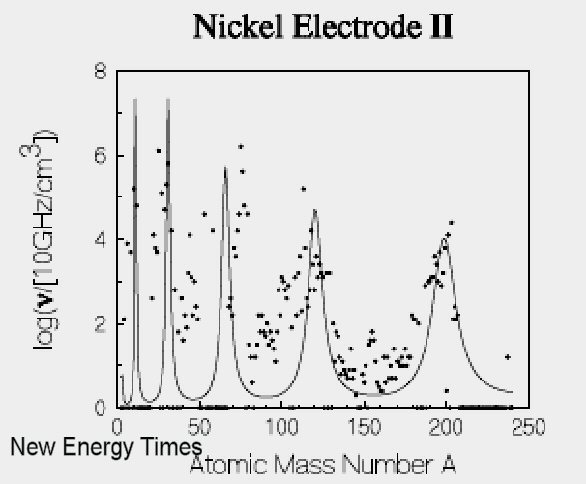
The graph below shows the five-peak spectrum as drawn by Miley in 1996, based on his experimental data of the production rate of various anomalous isotopic abundances.
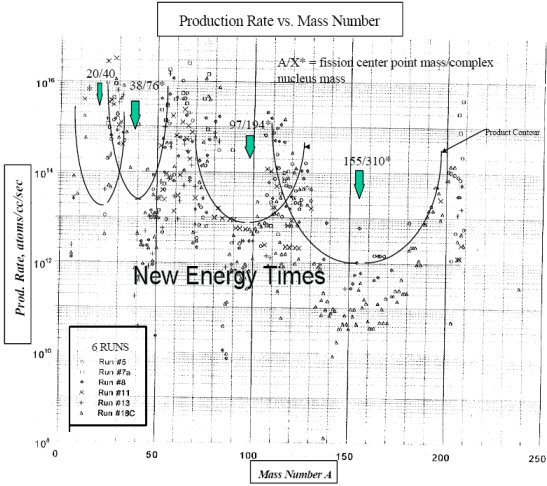
New Energy Times has found several other papers that appear to be related to the Widom Larsen theory.
Numerous papers relating to the relationship between surface plasmons and laser stimulation have been written by Italian researchers at La Sapienza University and the ENEA Frascati Research Center, both in Italy. The laser effect was initially developed by Texans Dennis Letts and Dennis Cravens.
A theoretical paper by Ronald Bourgoin suggesting a mechanism to transmute (change) nuclear waste into nonradioactive material was also published recently.
Bourgoin taught mathematics and physics for 25 years and is the director of the evening college at Edgecombe Community College in North Carolina. His paper is titled "Transmuting Nuclear Waste by Use of a Quasi-Superconductor."
New Energy Times has received several critiques of the Widom-Larsen theory.
The first is from Akito Takahashi of Osaka University, a proponent of another LENR theory, who is president of the International Society for Condensed Matter Nuclear Science and was chair of the most recent International Conference on Condensed Matter Nuclear Science.
His critique was presented in the paper "Progress in Condensed Matter Nuclear Science" and published in the proceedings of the 12th International Conference on Condensed Matter Nuclear Science (p. 21-23, World Scientific, 2006). It is excerpted here.
|
Takahashi Critique of Widom-Larsen Theory
1) Production cross section of heavy electrone* is not given, so that we cannot argue on density of very-low-momentum neutron (VLMN) available in matter, taking into account 10 min beta-decay of neutrons and assumed neutron-conversion cross section (see 3). If neutron density were greater than 1E+16 per cm^2 on surface, neutron reaction rate with H and host metal-nuclei were realistic level as experiments claim. According to neutron decay and inelastic phonon-scattering with lattice vibration, which is up-scattering to higher neutron energy, we need to estimate mean existing time of VLMN on surface. (I guess VLMNs get phonon energy with several barns of cross section and very rapidly in less than one microsecond leak out.)
2) Proton (deuteron) on metal surface lattice vibrates with (1/2pi)h-omega, as Einstein oscillator, and has recoil energy of about 30 meV. VLMN converted from proton should conserve this 30 meV as kinetic energy which is a little more than averaged (thermal equilibrium) energy of 25 meV in media at room temperature. (Einstein oscillator can have higher zero-point energy than Debye oscillators of metal atoms.)
3) Cross section for p + e* to n + neutrino is not given. I think this cross section (over threshold energy as Widom-Larsen show) should be very small, on the order of 1E-26 of usual strong interactions. And neutrino here is different from electron-neutrino and muon-neutrino. This cross section (or transition matrix) estimation is key problem for making the Widom-Larsen theory realistic!
4) Li-6 + n to He-4 + t + 4.8 MeV channel has about 1000 barns at En=25 meV, compared with very small cross section 4E-2 barns for n-capture, Li-6 + n to Li-7 + gamma. And Li-7 + n to Li-8 to Be-8 + beta to He-4 + He-4 + e process has 4E-2 barns at En= 25 meV, only. So it is well-known that Li-6 + n to He-4 + t + 4.8 MeV is predominant channel! Since reaction rate per neutron flux is (cross section)x(velocity) and cross section at lower energy than 30 meV has 1/v law, all reaction rates keep constant according to the change of momentum or kinetic energy. So that, even at very low energy, reaction rate does not increase, so I think Widom-Larsen misunderstand these points.
5) If p + e* state exists, it should have transition to mini-atom orbit which should emit photons greater than 13.6 eV of H-atom ground state. (This has some sort of relation to Randy Mills' sub-orbital quantum state, hydrino!) We need to estimate lifetime of e* becoming heavy by Widom-Larsen's oscillating electro-magnetic plasmon interaction on surface.
6) If hard gamma-rays were totally absorbed by e*, we can easily test using a standard gamma-ray source to measure gamma-peak attenuation through the sample metal-hydride surface. We have no data for Compton scattering with e*, which they assume very large to neglect gamma-electron processes with metal-atoms having usually much larger photo-electric, Compton and pair-creation cross sections compared with those for hydrogen atom.
7) We know, dde*(mass=208m-electron), namely muonic dd-molecule does not emit low energy neutrons (but 2.45 MeV neutron by d-d fusion), although Widom-Larsen theory suggests dde* to d + n+ n break-up. |
The second critique is from Scott Chubb of the Naval Research Laboratory, also a proponent of another LENR theory, and co-chair of the 2003 International Conference on Condensed Matter Nuclear Science. This critique is excerpted from a longer review that will appear in Infinite Energy magazine.
|
Chubb Critique of Widom-Larsen Theory
Meshuga, Yiddish for crazy, is the word that most physicists would use to describe Low Energy Nuclear Reactions. In fact, during the National Science Foundation-Electric Power Research Institute workshop in October 1989, Edward Teller suggested that LENR (at that time called cold fusion reactions) could only be explained using a new particle, the meshuganon, or crazy particle. Teller envisioned a large—that is, heavy—neutral particle that somehow could create room-temperature nuclear reactions. Although more-credible theories for explaining LENR exist, this "Meshuganon" idea has not disappeared. Its latest reincarnation is embodied in the theory proposed by Widom and Larsen [1-4].
These theorists suggest that the most important deuteron (d) + d reactions in palladium (Pd) deuteride (PdD) occur through a bizarre series of transitions, involving a form of weak interaction (in which neutrons are created), resulting from large electric fields at the surfaces of Pd electrodes.
There are two problems here, however. It is difficult to believe that the kinds of electric fields that are required could exist, and the energy released by the reaction, as documented by McKubre (SRI International) and others, which simply is entirely consistent with d+d -> 4He, is not at all consistent with their model.
Considerably simpler models, based on conventional physics, in principle, can explain this reaction. In particular, McKubre[5] has shown in a rather compelling way that the associated reactions release the energy, 23.8 MeV, which is appropriate in conventional d+d -> helium-4 reactions and is simply wrong if the "Meshuga" theory, suggested by Widom and Larsen, is correct.
The fact that Widom and Larsen have not recognized this fact possibly reflects their ignorance of the existing literature and lack of involvement with International Conference on Condensed Matter Nuclear Science series, in particular. Possibly, they are ignoring this fact, based on their own biases. Regardless, it is important and essential to call into question the soundness of their arguments, as they relate to PdD.
On the other hand, their idea of a Meshuga theory fits quite well with the "craziness" of some of the other effects that have been observed in LENR, and, in fact, believing that the Widom-Larsen theory might apply to some of these reactions is not entirely crazy. The WL theory includes effects, involving relativistic quantum mechanics, that are quite appealing, especially to high-energy physicists.
On the other hand, WL have failed, abysmally, to cite earlier work related to similar "theories." For this failure, at best their presentation of their "theory" can be viewed as being misguided. At worst, what they have done should be viewed as being unethical. I hope that, in the future, they will refer appropriately to earlier work by others in the field.
A key point is that WL do present reaction rate expressions that appear to be related to experimental results. This is important because it provides a useful framework for analyzing the associated effects. Schwinger, Preparata, Li, Chubb and Chubb, Hagelstein, and Kim have done this. No "theory" can be taken seriously that does not provide an explanation of experimental information that is based on appropriate reaction rate expressions.
A nice aspect of the WL model is that not only does it make use of existing physics and an appropriate formulation of it, but it also creatively brings together "Meshuga" ideas that are widely believed to be irrelevant, in a cogent, albeit hard-to-believe way that all at once must be viewed as being creative, sincere, possibly right in certain circumstances but, beyond anything else, breathtaking and Meshuga.
[1] A. Widom and L. Larsen, "Ultra low momentum neutron catalyzed nuclear reactions on metallic hydride surfaces," Euro Phys Journ C, 46, 107-111 (2006).
[2] A. Widom and L. Larsen, "Absorption of Nuclear Gamma Radiation by Heavy Electrons on Metallic Hydride Surfaces," submitted for publication (2006).
[3] A. Widom and L. Larsen, "Nuclear Abundances in Metallic Hydride Electrodes of Electrolytic Chemical Cells."
[4] A. Widom and L. Larsen, "Theoretical Standard Model Rates of Proton to Neutron Conversions Near Metallic Hydride Surfaces."
[5] P.L. Hagelstein, M.C.H. McKubre, D.J. Nagel, T.A. Chubb, and R.J. Hekman, "New Physical Effects in Metal Deuterides," in Condensed Matter Nuclear Science, Proceedings of the 11th International Conference on Cold Fusion [ed. J.P. Biberian, World Scientific, New Jersey, 2006], pp 23-59. |
New Energy Times received a critique of Widom and Larsen's fourth paper from a particle physicist in the Navy who wishes to remain anonymous.
|
Anonymous Critique of Widom-Larsen Theory
From: xxxxxxx.navy.mil]
Sent: Monday, September 11, 2006 15:19
To: xxxxxxxxxx
Cc: xxxxxxx
Subject: Re: Metal Hydride cathode catalysis of e + p -> nu + n
Hi xxxx.
I've finished looking through the paper.
Important qualifier: it has been awhile since I have thought about these types of calculations, so take this with a grain of salt.
My overview:
This paper uses standard quantum field theory (nonrelativistic limit) and various uniformity and simplest-case-type assumptions to calculate an estimate of the rate for p + e- -> nu (neutrino) + n (neutron). The techniques used are all conventional and frequently used. There are a number of simplifying assumptions made that then allow a simple closed-form estimate. The final estimate is that the rate is of order 10^13 to 10^14 per unit area per unit time when a cutoff parameter (expressed in terms of effective electron mass) is exceeded. It is claimed that this is compatible with observed rates.
The basic idea is straightforward and closely related to basic semiconductor physics where "holes" (vacancies in a lattice) can be treated as massive charged particles—the net effect of the medium is to add an "effective mass" (to a pretty good first-order approximation). Normally one would not expect a significant transition rate because the reaction is energy-forbidden (mass(p) + mass(e-) <mass(n) by a significant amount). However, due to the strong currents and surface effects at a metal hydride cathode, there will be significant radiation field interaction with electrons in this zone. This radiation field interaction, to lowest order, can manifest as an increased "effective mass" for electrons. If the effect is great enough, the reaction can proceed.
This idea seems reasonable. The authors use a four-fermi vertex interaction to estimate the rate. I followed through the work and all calculations seemed to be consistent with standard practice, and to be correct so far as I can tell. I can't say that I followed every factor of pi through.
The baryon operators (p, n) are handled in terms of isospin, should be a good approach for the nonrelativistic regime here. A standard phase space integration is used to compute the transition rate; I don't see any problems with it.
My assessment:
The basic idea seems reasonable; I don't see any reason it shouldn't be correct. In fact, it is the most obvious way to proceed.
All the calculations seem to be correct as far as I can tell. If there is any problem (it seems to me), it is in the assumptions made for simplification, or in something subtle that would prevent the sort of straightforward approach the authors use. Thus I list the key assumptions I saw and my guess as to their impact here.
1. "if there are n(2) ~ 10^15/cm^2 effective (e*- p+) pairs per unit surface area [in the surface zone] ..."
- I haven't a clue as to if this is reasonable or not (chemists might know better!). It would at least seem to be compatible with Avogadro's number, for what that is worth. BTW, this number is key to the estimated rate.
2. Non-relativistic
- Likely fine. Slight possibility of issues with mass(W).
3. Surface isotopic spin wave approach
- Seems good to me.
4. Patch size for the isotopic spin wave
- I don't know how to estimate this. A good distribution for this would likely permit a neutron energy-spectrum estimate, which would be a good verification tool.
5. The effective mass wave function transformation
- I can't see why this wouldn't be correct
6. Proton spins are uncorrelated and free neutron density is dilute
- Neutron density dilute almost certainly correct. Proton spins- I don't know.
7. "The calculation of K depends on the detailed physical properties of the cathode surface as well as the flux per unit area per unit time of electrons ..." "In the most simple model, let us consider a smooth surface ..."
- Gory details could be important, as authors note.
8. "... let us consider ... electron currents ... via the mass renormalization parameter beta as defined in eq. 46."
- Basically after lots of calculation and some simplifying assumptions, the authors just *assume* that the mass renormalization approach is the way to go. This happens between equations 61 and 62 and is key to the result. I suspect the authors are right ( can't see why this wouldn't be correct, as per 5 above), but more work could go into this step.
9. Infrared/Ultraviolet cutoffs
- In such a radiative coupling rich environment, cutoffs could impact this approach. In the strictly nonrelativistic four-point vertex, I think is probably OK. I think.
Bottom line:
Techniques and calculations are straightforward, and (as far as I can tell) correct. There could be some assumptions that need to be dealt with in more detail (could spell trouble). My "feel" is that they are OK.
The paper looks good to me. It's a clever idea, I think (clever ideas are always obvious in hindsight).
Best,
xxxxx |
Finally, the following critique was received from Dr. Robert Deck of the University of Toledo.
Deck Critique of Widom-Larsen Theory
March 14, 2007
Below is my review of the four papers by Widom and Larsen listed here. [Ed. note: For links to these papers online, see the publication list on our Widom-Larsen Theory page.]
#1 (March 9, 2005 ) "Ultra Low Momentum Neutron Catalyzed Nuclear Reactions on Metallic Hydride Surfaces" Eur. Phys. J. C (2006) THE EUROPEAN PHYSICAL JOURNAL C
#2 (Sept. 10, 2005) "Absorption of Nuclear Gamma Radiation by Heavy Electrons on Metallic Hydride Surfaces"
#3 (Feb. 20, 2006) "Nuclear Abundances in Metallic Hydride Electrodes of Electrolytic Chemical Cells"
#4 (Aug. 25, 2006) " Theoretical Standard Model Rates of Proton to Neutron Conversions Near Metallic Hydride Surfaces"
The theory of Widom and Larsen presented in the above manuscripts offers an explanation of the phenomena observed in chemical electrolytic cells employing metallic hydride electrodes (and formerly attributed to "cold fusion").
Experiments conducted in many laboratories using electrolytic cells with metallic hydride electrodes have confirmed the detection of both excess heats of reaction and anomalous low energy nuclear transmutations. Rather than attributing these effects to reactions involving nuclear fusion, the Widom-Larsen theory attributes these phenomenon to weak interactions in which an electron in an EM field combines with a proton to produce a low energy neutron and a neutrino, and the subsequent absorption of the neutron by a nucleus.
The proposed weak interaction process is impeded by (1) the small mass of the electron and proton compared to that of the neutron and (2) the low interaction rate characteristic of weak interactions.
The authors demonstrate that the first obstacle is surmounted under the condition that the mass of the electron is dressed by strong electromagnetic fields derived from surface plasmon modes on the metallic hydride electrodes. The argument in support of this explanation is given (elegantly) in Ref. 1 and in more detail in Ref. 2.
The authors address the second obstacle to the proposed process in Ref. 4, where they conclude that the weak interaction production rate for neutrons is sufficiently large to be consistent with experimental observations. The conclusion is based on both a rough estimate of the production rate, primarily derived from the values of coupling constants, and a more detailed derivation heavily dependent on the formalism of quantum field theory (the latter of which this reviewer, despite a background in field theory, is unable to either verify or disprove).
In addition to providing an explanation for the excess heats of reaction and low energy nuclear transmutations observed in catalysis experiments using metallic hydride electrodes, the Widom-Larsen theory appears to lead to the following testable predictions:
(1) Enhancement of the observed anomalous effects in the presence of laser light incident on the metallic hydride surfaces.
(2) The absence of high energy neutron emission.
(3) The production of copious soft photons.
(4) The non-necessity of deuterium for production of the characteristic effects observed.
(5) The enhancement of nuclear transmutations under the condition of nearly pure proton or nearly pure deuterium systems that better support coherent collective oscillations.
In connection with point (4), Widom and Larsen point out that, whereas electron capture by a deuteron produces an extra neutron, it also requires a renormalized electron mass higher than that needed for electron capture by a proton.
A potential weakness of the Widom-Larsen theory is its reliance on estimates of certain physical quantities. Specifically, the correctness of the author's determination of the renormalized mass of the electron appears to rely on estimates of both the amplitude and the frequency scale of the electric field
oscillations given in Ref. 1; similarly, the determination of the neutron mean free path appears to rely on an estimate of the neutron forward scattering amplitude.
In addition, the theory provides no clear explanation for the excitation of the surface waves resulting in the enhanced electric fields needed to renormalize the electron's mass. In particular, whereas the introduction in Ref. 1 provides an elegant derivation of the dressed mass of the electron produced by a fluctuating electromagnetic field, the point of the initial part of the following discussion on "proton oscillations" eludes me.
The implication is that neutron scattering on protons excites the surface proton oscillations at frequency omega, producing the time-varying electric field that renormalizes the electron's mass.
Instead, the theory appears to require the existence of strong EM field oscillations before the neutrons can be produced.
The theory of the authors, and that based on cold fusion, predicts the production of hard gamma photons not seen in experiments. In Ref. 2, the authors provide an explanation for the nonobservance of hard photons produced by neutron absorption in nuclei on the basis of classical and quantum mechanical derivations of an ultra-short mean free path for hard photon absorption by dressed electrons and their re-emission as multiple soft photons. Included in the same Ref. 2 is a demonstration of the well-known impossibility of absorption of a photon by a free electron (which the authors overkill on page 4 of Ref. 2).
Ref. 3 presents the only direct comparison with data. Here, the authors use a simple optical model potential for the nucleus to estimate the cross section for nuclear absorption of a neutron. This simple model produces a graph of absorption probability versus nuclear mass number A in reasonable agreement with the data.
Experiments find transmuted nuclei with mass numbers as high as 200 in electrolytic cells with electrodes consisting of nickel atoms with an A number only around 60. This experimental evidence for transmuted nuclei with high A, combined with the authors' plausible demonstration that the transmutation processes in electrolytic chemical cells can be produced by low
energy neutrons, suggests that the most significant aspect of the experiments in chemical electrolytic cells may be an alteration in the theory for the production of elements.
Finally, despite the reservations expressed above, I conclude that the mechanism proposed in the Widom-Larsen papers provides a far more compelling explanation of the anomalous phenomenon observed in electrolytic chemical cells than previous theories. Unfortunately, this implies that electrolytic cells using metal hydride electrodes are unlikely to provide a practical source of energy.
Given that the Widom-Larsen theory is correct, the energy you can expect to generate in the electrolysis cell is much less than it would be if the process involved in the cell was the fusion of deuterium nuclei. This is because in the Widom-Larsen process, the production of neutrons via the merger of an electron and a proton actually requires input energy; whereas the capture of neutrons by nuclei produces some energy in the form of hard gamma photons and beta particles (which gets turned into heat), therefore, it's not comparable to that produced in fusion.
More likely, careful measurements of the production rates of nuclear transmutations observed in experiments based on these cells can alter the theory for the production of the elements in the universe.
|
__________________________________________________________________________________
13. PUBLICATIONS
Repeatable Experiment Producing Evidence of Charged Particles
Szpak, S., et al., "Further Evidence Of Nuclear Reactions In The Pd/D Lattice: Emission Of Charged Particles," Naturwissenschaften, DOI 10.1007/s00114-007-0221-7 (March 2007)
Theory for Transmuting Nuclear Waste based on Widom-Larsen Theory
Bourgoin, R., "Transmuting Nuclear Waste by Use of a Quasi-Superconductor," Acta Physica Polonic B, Vol 38, (Jan. 15, 2007)
Summary Paper—Experimental View—Excess Heat
Hubler, G., "Anomalous Effects in Hydrogen-Charged Palladium—A Review,"
Journal of Surface & Coatings Technology, (10.1016/j.surfcoat.2006.03.062)
__________________________________________________________________________________
14. SCIENCE AND ENERGY NEWS
Click on any headline to read the entire article.
Purdue Inquiry Clears Bubble Fusion Researcher
By Associate Editor Erico Guizzo
IEEE Spectrum
Friday, February 9, 2007
Purdue University announced this week that an internal inquiry has cleared nuclear engineering professor Rusi P. Taleyarkhan of allegations of research misconduct made against him nearly a year ago. Taleyarkhan is the leading proponent of what is known as bubble fusion, or sonofusion, which uses high-frequency sound waves to implode bubbles in a liquid, producing thermonuclear fusion. If the method works and can be scaled up, it could yield sizable amounts of energy.
(article continues)
Panel Clears Nuclear Engineer
Associated Press
Friday, February 9, 2007
WEST LAFAYETTE, Ind., Feb. 8—A panel has rejected allegations that a Purdue University nuclear engineer interfered with efforts to verify his claims of producing "tabletop fusion."
The internal university committee investigating the work of professor Rusi Taleyarkhan determined that the evidence does not support allegations of research misconduct and that no further investigation is needed, Purdue said Wednesday.
(article continues)
Tabletop Fusion Claims Ignite a Furor at Purdue
By Jeremy Manier
The Chicago Tribune
Friday, February 9, 2007
Accusations of research misconduct have roiled the school of nuclear engineering at Purdue University over the last year, stemming from one professor's claims to have discovered a potential source of cheap energy through tabletop nuclear fusion.
The target of the allegations was exonerated this week in an academic report. But the inquiry's end is unlikely to quell the rivalries and professional trash-talking spurred by Purdue engineering professor Rusi Taleyarkhan's work.
(article continues)
Second Inquiry Exonerates Taleyarkhan
By Robert F. Service
ScienceNOW Daily News
Wednesday, February 7, 2007
Purdue University officials today announced that a second and final internal inquiry has cleared bubble-fusion researcher Rusi Taleyarkhan of all allegations of research misconduct. "I feel vindicated and exonerated," Taleyarkhan says. "It's been a pressure cooker for about a year." But controversy surrounding Taleyarkhan's work isn't likely to die down any time soon.
Taleyarkhan is the chief proponent of the controversial notion of sonofusion, which suggests that sound energy can collapse bubbles in a way that yields more energy than was initially put in (Science NOW, 4 March 2002). Last year, an article in Nature reported that several of Taleyarkhan's colleagues at Purdue were upset by their encounters with him, suggesting that he allegedly obstructed their work and tried to stop them from publishing results that contradicted his own.
(article continues)
7-Eleven Sells Super-Charged Coffee
NBC5i.com
February 26, 2007
DALLAS—In an effort to attract the 18- to 24-year-old crowd, Dallas-based 7-Eleven is now selling coffee fused with additional energy boosters.
Fusion Energy Coffee contains guarana, ginseng and yerba mate—ingredients often found in energy drinks, NBC 5 reported. The new coffee, which costs the same as other coffees sold by 7-Eleven, is served in bright yellow pots.
(article continues)
The Daylight 'Savings' Canard
By Max Schulz
The Washington Post
Wednesday, March 14, 2007
The 2005 energy bill didn't provide any meaningful measures to expand domestic supplies of energy, opting instead for gimmicks like extra DST. Extra Daylight Savings Time is simply legislative sleight of hand designed to make citizens think they are getting something they are not. The simple fact is that Congress can't create any extra sunlight. DST's gains will be illusory, meaning what we experienced this past weekend is energy policy as Three-card Monty. Ladies and Gentlemen, step right up.
(article continues)
Tech Barons Take on New Project: Energy Policy
By Matt Richtel
The New York Times
Monday, January 29, 2007
President Bush set broad goals last week for the adoption of alternative energy. Hoping to take on the role of filling in the details is an unlikely group: Silicon Valley's technology investors.
These venture capitalists, backers of giants like Google and Genentech, have traditionally been free-market advocates, favoring ideas and innovation over government intervention. Now they are heading to Washington on a crusade to influence energy policy because they have a big stake in the outcome.
The investors in recent years have poured billions of dollars into alternative energy start-ups in areas like solar and wind power or the production of fuel for cars from feedstock and crop waste. Many of these projects, they say, could stall without subsidies or government mandates for greater energy efficiency.
These barons of the new economy are not new to politics, though their interest in energy places them in a powerful spotlight. And it puts them in conflict with the oil and gas industries, which are more politically potent and have far deeper pockets.
(article continues)
Practical Fusion, or Just a Bubble?
By Kenneth Chang
The New York Times
Tuesday, February 27, 2007
Brian Kappus, a physics graduate student at U.C.L.A., tipped the clear cylinder to trap some air bubbles in the clear liquid inside. He clamped the cylinder, upright, on a small turntable and set it spinning. With the flip of another switch, powerful up-and-down vibrations, 50 a second, started shaking the cylinder.
A bubble floating in the liquid-phosphoric acid-started to shine, brightening into an intense ball of light like a miniature star.
The shining bubble did not produce any significant energy, but perhaps someday it might, just like a star. A few small companies and maverick university laboratories, including this one at U.C.L.A. run by Seth Putterman, a professor of physics, are pursuing quixotic solutions for future energy, trying to tap the power of the Sun-hot nuclear fusion-in devices that fit on a tabletop.
Dr. Putterman's approach is to use sound waves, called sonofusion or bubble fusion, to expand and collapse tiny bubbles, generating ultrahot temperatures. At temperatures hot enough, atoms can literally fuse and release even more energy than when they split in nuclear fission, now used in nuclear power plants and weapons. Furthermore, fusion is clean in that it does not produce long-lived nuclear waste.
Dr. Putterman has not achieved fusion in his experiments. He and other scientists form a small but devoted cadre interested in turning small-scale desktop fusion into usable systems. Although success is far away, the principles seem sound.
(article continues)
Going Nuclear
By Patrick Moore
The Washington Post
Sunday, April 16, 2006
In the early 1970s when I helped found Greenpeace, I believed that nuclear energy was synonymous with nuclear holocaust, as did most of my compatriots. That's the conviction that inspired Greenpeace's first voyage up the spectacular rocky northwest coast to protest the testing of U.S. hydrogen bombs in Alaska's Aleutian Islands. Thirty years on, my views have changed, and the rest of the environmental movement needs to update its views, too, because nuclear energy may just be the energy source that can save our planet from another possible disaster: catastrophic climate change.
Look at it this way: More than 600 coal-fired electric plants in the United States produce 36 percent of U.S. emissions—or nearly 10 percent of global emissions—of CO2, the primary greenhouse gas responsible for climate change. Nuclear energy is the only large-scale, cost-effective energy source that can reduce these emissions while continuing to satisfy a growing demand for power. And these days it can do so safely.
(article continues)
__________________________________________________________________________________
Support New Energy Times(tm)
New Energy Times (tm) is a project of New Energy Institute, an independent 501(c)(3) nonprofit corporation that provides information and educational services to help bring about the clean-energy revolution.
The New Energy Times (tm) newsletter, Web site, and documentary projects are made possible by the generous contributions of our sponsors and supporters.
We invite you to join with us in this effort to help bring about a better future for all of earth's current and future residents.
__________________________________________________________________________________
Administrative
Copyright 2007 New Energy Times (tm)
Publication, in print or electronically, is not permitted without express written permission.
|

